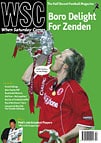 While today graffiti is a public method of making coded statements, in the 1970s it was about football and plain speaking, if not always great spelling, as Jim Heath recalls
While today graffiti is a public method of making coded statements, in the 1970s it was about football and plain speaking, if not always great spelling, as Jim Heath recalls
Apart from Arsenal fans spraying their hair red in honour of Freddie Ljungberg, it’s been a long time since spray paint played an active part in the football supporters’ repertoire. Football graffiti had its heyday in the early 1970s when it gave crumbling stadiums that extra, almost indefinable character, the worn brick and corrugated iron surrounds of the terraces being a perfect canvas for budding artists. It wasn’t just restricted to the grounds themselves, with daubings on all points from the city centres and railway stations. Given its intimidatory presence which heightened the fear that you were going to get your head kicked in, it’s ironic that the graffiti trend was inspired mainly by the 1960s peace movement, who used it to protest against the Vietnam war and express support for Castro’s Cuba (“LBJ get out of Vietnam” was still visible on a wall opposite the Craven Cottage turnstiles into the 1980s).
Slogan spraying wasn’t just the home fans’ domain – slipping an aerosol spray can in your Crombie pocket was soon to become an essential away-day accessory for any self-respecting boot boy. Woolworths’ Winfield brand was the most popular as it was relatively cheap and simple to operate. Visiting fans used to spray paint club names, ends or slogans on strategically important areas around the home team’s ground to let them know that they had been there – or “taken liberties on their manor” in the parlance of hooligan authors.
To avoid being caught, the message had to be short so team initials were popular as well as simple slogans – a lesson not heeded by a Leicester City fan on a trip to my home town, Wolverhampton, in 1972. Having made it very close to Molineux a quick “LCFC” or “Foxes” would have sufficed. However, ambition got the better of this perpetrator and an untidy and misspelled “Leciester City”, albeit in a striking blue, appeared. An attempt to amend the mistake made matters worse with the “ci” struck through and rewritten above. It merely reinforced the impression that these people were, in fact, delinquents.
The fact that graffiti was generally associated with vandalism and anti-social behaviour is one of the reasons why football never got any credit for its role in the art form as it belatedly gained cultural acclaim on the back of punk. The early Clash in particular used spray paint as a fashion accessory – bass player Paul Simonon often talked of his teenage years running with The Shed at Chelsea, where he obviously honed his aerosol skills. My own brief flirtation was in fact a trip to Stamford Bridge in 1973, where a “Doog is King” was inscribed on the southbound exit tunnel at Toddington services. This particular effort may well have long vanished, but similar sentiments survived for many years on a bridge over the A14 leading in to Ipswich. The surrounds of railway stations, subways and clearings remain a rich seam for football graffiti spotting. Paeans to the “Kop” and “Stretford End” can still be seen on train journeys through the north-west. Much rarer, though, is anything ending in “…rules OK!”. An enterprising Merseysider deserves a mention for packing his aerosol for a summer holiday and leaving “Everton” scrawled all over Magaluf.
Not all graffiti was hooligan related, of course. The photographer Peter Robinson included in his recent Football Days collection a great shot of a wall in Manchester with names of the entire Spurs team of the late 1960s in classic 2-3-5 formation. Today the Tour de France appears to be the only sporting event where graffiti plays an active role, with fans spraying messages of support for riders on roads in the mountains.
It declined here due in part to closed-circuit television and increased ground entry search procedures. Supporters used other outlets to express their feelings – hence a proliferation of banners, flags and sensible behaviour generally. Anyway, it just doesn’t seem quite right in shiny all-seat stadiums. In the 1980s the trend was developed by hip-hop graffiti artists/rappers such as the Bronx’s Futura 2000. Suddenly UK city landscapes were covered in strange writing you couldn’t read and images totally unrelated to football. Today, urban graffiti doesn’t sit well against local authorities’ environmentally friendly policies and many councils are very active in dealing with it. In Manchester special clean-up teams patrol in customised hose-vans and impose severe penalties on perpetrators. In November, magistrates in Stockport sentenced a certain Jack Jones to six months’ detention for causing £30,000 worth of damage to trains and stations. The poor chap was also banned from carrying spray paint for two years. So if you are thinking of a football revival for the phenomenon, it’s probably best kept to your hair.
From WSC 206 April 2004. What was happening this month